| . .






. .
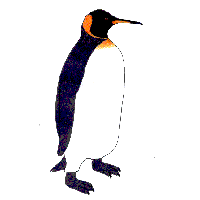
. . . .
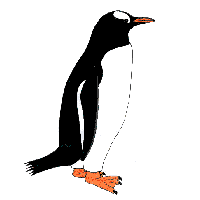
. . . .
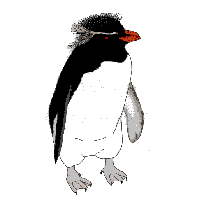
. . . .
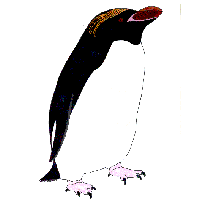
. . . .
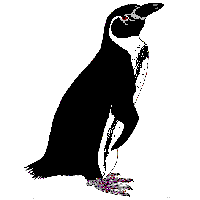
. . . .
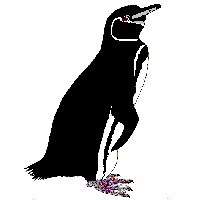
|

|
 Threats to Penguins Threats to Penguins
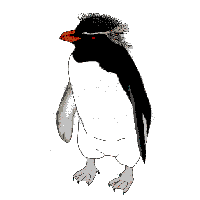
Man's remarkable ability to destroy wildlife is demonstrated by the first bird to be named a penguin, the Great Auk. Unlike real penguins, the Great Auk lived in the northern hemisphere where human population was higher. Because it was flightless, the Great Auk made an easy target for sailors who killed them for food, and the Great Auk became extinct during the 19th Century. Penguins of the southern hemisphere also suffered at the hands of early sailors.
Before petroleum products became available, lighting was either by candle or by oil lamp. The oil for lamps came from whales, and the southern oceans were frequented by large numbers of whaling ships. Whales, seals and penguins all have layers of sub-cuticular fat to protect them from the cold, and this fat was melted down by the whalers in huge metal pots, for shipment home in barrels. Because of their high fat content, penguins burn well, and were often used to fuel the fires beneath these pots. The penguins were just thrown into the burning fire, often whilst still alive.
The rapid development of petroleum products put an end to the demand for whale oil, although whaling for meat has continued until the present day. Even now that the southern oceans have been declared a Whale Sanctuary, countries such as Japan and Norway continue to ignore international agreements that ban whaling. Fortunately penguins are no longer slaughtered in large numbers for oil, but they are still killed for food or fishing bait in some areas.
In Peru, Humboldt Penguins are sometimes killed illegally for food or fishing bait. Fisherman along the remote coastal reaches of southern Chile also kill Magellanic Penguins for use as bait in crab pots. In many areas penguins are caught in gill-nets laid by local fisherman, and breeding sites are disturbed by the illegal taking of penguin eggs for food.
Penguins are the major avian top-predators in the southern oceans. The entire world population of all penguins consume around 20 - 25 million tons of fish, squid and crustaceans every year. By way of comparison, the world's commercial fisheries remove around 70 million tons per year. Because penguins breed in very large numbers at particular sites, and generally forage within a range of 50km, there is considerable local competition for food. Breeding colonies therefore rely on highly productive feeding areas within their daily foraging range, in order to sustain chick production. Any significant reduction in food abundance within this foraging zone is likely to have adverse affects on chick-rearing ability.
This makes such areas particularly susceptible to commercial fishing operations, which are also trying to target the same highly productive feeding areas. This situation is exacerbated when the commercial fishing activities take place just prior to or during the breeding season, as is currently the case in the Falkland Islands. Any reduction of prey in these all important foraging areas, at a time when penguins are unable to forage further afield, and when extra food is required for chicks, can seriously reduce chick survival rates. Whilst commercial fisheries are generally reluctant to curtail activities in the interests of preserving wildlife, in some instances rescheduling activities, or the establishment of exclusion zones around breeding colonies, can be of enormous benefit to wildlife without being economically damaging.
It is estimated that 40,000 Magellanic Penguins are killed by oil pollution along the coast of Argentina every year. This oil mostly comes from deliberate operational discharges, such as the emptying of oily ballast water, rather than from accidents. African Penguin populations have been devastated by oil pollution resulting from both operational discharges, and a number of shipping accidents along the coast of South Africa. In January 2001, a tanker ran aground and caused a major oil spill in the Galapagos Islands, where the world's rarest penguin is struggling to avoid extinction.
Because oil tankers are designed to function when fully laden with oil, empty tankers returning to collect another load, must fill the empty tanks with sea water to act as ballast. This oily water should then be discharged at the terminal prior to loading up with fresh oil, in order to prevent oil being discharged into the sea, but this practice is often ignored. Because it is time-consuming to pump the oily water from the tanker at the terminal, the water is often discharged directly into the ocean a few miles before reaching the terminal, in order to make loading faster. The consequences of such malpractice can be devastating to local wildlife, but enforcing better practices can be almost impossible, even for willing governments.
Oil tankers are governed not by the country whose waters they sail in, but by the country with whom the tanker is registered. Not surprisingly, tankers are often registered under countries with the lowest safety and environmental safeguards, such as Panama, and can operate virtually beyond the law. Not only do they continue to discharge oil without fear of prosecution, in order to save money, but often the tankers themselves are poorly maintained, and operated by crews that are untrained in emergency procedures.
Adequate safeguards must be taken to ensure that the highest standards of environmental protection are put in place, to reduce both operational discharges, and to prevent accidents. The problem lies in the fact that governments often claim that they are doing just that, up until the point that an accident proves otherwise. Following major spills around the world, experts often claim to identify the reasons behind the incident, and make changes to regulations to ensure that such accidents cannot happen again. Whilst such measures should be commended, it does allow for complacency to return once more.
Shipping accidents are like car accidents: despite continuous improvements to design and regulations, accidents will inevitably happen. It is therefore essential to have adequate contingency plans to deal with such emergencies, and plans that will be effective in all weather conditions. Most accidents occur in rough weather, and contingency plans must be able to operate under such conditions. It is amazing how many rescue plans cannot be put into operation following a spillage, because they can only be executed in fair weather.
Penguins are amongst the most sensitive of birds to marine oil pollution. Being flightless and having to surface regularly to breath, they are unable to avoid being coated by oil in their vicinity, even when in the open ocean. In addition, because penguins' line of sight is at sea level, they are often unable to see surface oil ahead of them until its too late.
Penguins oiled by operational discharges are usually coated out at sea, without the oil ever being noticed on the beaches. International attention is only drawn to the affects of major oil spills, when birds become polluted ashore in large numbers, but in actual fact the daily mortality of penguins by small scale discharges is far more damaging than a one-off disaster.
Oiled penguins that have been rescued and cleaned, have been shown to have a much higher survival rate than other seabirds. Oil coats the feathers of all birds, and breaks down the insulation given by the plumage, however penguins have layers of subcuticular fat deposits which help prevent hypothermia. In addition, penguins are more tolerant of handling than most birds, and are very sociable, which allows them to be housed in large numbers without causing excessive stress. Nevertheless, although cleaning oiled birds can be fairly successful on a small scale, it rarely saves more than a tiny proportion of the victims from a large spill, and can never be considered as a serious proposal for mitigating the damage of large scale oil pollution.
Land-based human activities also threaten penguin populations. In Peru and northern Chile, the climate is so hot and dry that bird droppings accumulate to form mineral deposits several metres thick. With nothing but bedrock beneath, these guano deposits provide the only substrate for penguin burrows at many sites. The extraction of guano for use as fertiliser has left Humboldt Penguins with nothing to burrow into in some areas, destroying valuable breeding habitat.
The introduction of non-native predators also creates problems in some areas. The majority of penguins live on islands where there were no native mammalian predators, but in many areas man has introduced dogs, cats and rats, to the detriment of local wildlife. On islands such as Hawaii, rats and cats introduced by man have killed off much of the birdlife that once existed. Fortunately penguins are too large to be affected by rats and cats, but in Peru, northern Chile and the Galapagos Islands, wild dogs have killed penguins, and are a serious threat to penguin breeding sites.
Penguin breeding sites are also threatened by human disturbance in some areas. Little Blue Penguins in Australia are threatened by marina development, whilst in the Galapagos Islands make-shift shanties erected by illegal sea-cucumber fishermen disturb Galapagos Penguins and other wildlife. In general though, penguins are very tolerant of human presence. Studies into the affects of tourism are encouraging, and show that well managed tourist operations can operate without causing harm to penguin populations.
Web Page by Mike Bingham
|





